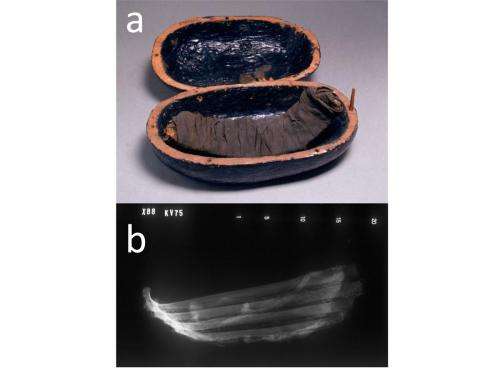November 19, 2013 report
Ancient Egyptians may have used balms to add flavor to mummified meat

(Phys.org) —The ancient Egyptians' elaborate preparations for the afterlife are well known. To ensure continued comfort and happiness after death, high status Egyptians had themselves interred with furniture, jewelry and even mummified pets. Many tombs contain pieces of mummified meat, wrapped in bandages and covered in balm. Richard Evershed of the University of Bristol and his team chemically analyzed the balms on some of these mummified meats. They believe the Egyptians used the balms for preservation and flavor enhancement. Their research appears in the Proceedings of the National Academy of Sciences.
Archeologists have discovered hundreds of meat mummies in ancient Egyptian tombs. Most of them are joints of meat or poultry, prepared as if for eating, then wrapped. Dark residue that covers the bandages looks like the organic balms applied to human and animal mummies. Until now, however, researchers have not known whether those who prepared the mummies intentionally added the balms to the meat.
To find out more, Evershed and his colleagues used gas chromatography-mass spectrometry to examine four pieces of mummified meat stored at the Cairo Museum and the British Museum. They found that the composition of the balms varied over time and think the ancient Egyptians added then deliberately.
External bandages from a victual calf mummy, dated from 1064 to 948 BC, in the tomb of Isetemkheb, the wife of a high priest, contained compounds made from animal fat. Because these compounds had no contact with the meat, the researchers think they were not grease from the meat, but a balm applied deliberately as a preservative.
Mummified goat tissue from around 1290 BC, taken from the tomb of the priestess Henutmehyt, also contained substances derived from animal fat. However, the researchers could not tell whether this came from the animal itself or whether the meat mummy's preparers added the substance as a balm. Mummified duck tissue found in the same food box did not contain any added fatty substance.
The most luxurious coating was on bandages covering mummified beef ribs, dated between 1386 and 1349 BC, found in the tomb of Yuya and Tjuiu, the parents of Queen Tiye, the wife of Pharaoh Amenhotep III. These bandages contained a mixture a fat or oil, beeswax and Pistacia resin, imported from the Mediterranean. Associated with royalty, Pistacia resin was used as incense, varnish and flavoring. The earliest known use of Pistacia resin in human mummification did not occur for another six centuries.
More information: Organic chemistry of balms used in the preparation of pharaonic meat mummies, PNAS, Published online before print November 18, 2013, DOI: 10.1073/pnas.1315160110
Abstract
The funeral preparations for ancient Egyptian dead were extensive. Tomb walls were often elaborately painted and inscribed with scenes and objects deemed desirable for the afterlife. Votive objects, furniture, clothing, jewelry, and importantly, food including bread, cereals, fruit, jars of wine, beer, oil, meat, and poultry were included in the burial goods. An intriguing feature of the meat and poultry produced for the deceased from the highest levels of Egyptian society was that they were mummified to ensure their preservation. However, little is known about the way they were prepared, such as whether balms were used, and if they were used, how they compared with those applied to human and animal mummies? We present herein the results of lipid biomarker and stable carbon isotope investigations of tissues, bandaging, and organic balms associated with a variety of meat mummies that reveal that treatments ranged from simple desiccation and wrapping in bandages to, in the case of the tomb of Yuya and Tjuia (18th Dynasty, 1386–1349 BC), a balm associated with a beef rib mummy containing a high abundance of Pistacia resin and, thus, more sophisticated than the balms found on many contemporaneous human mummies.
Journal information: Proceedings of the National Academy of Sciences
© 2013 Phys.org

















